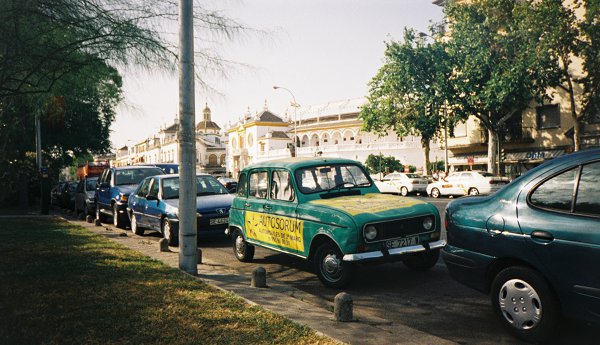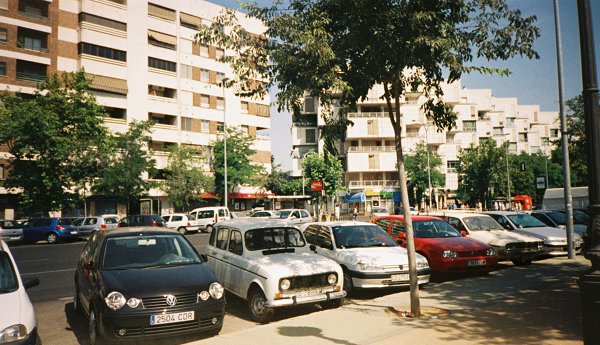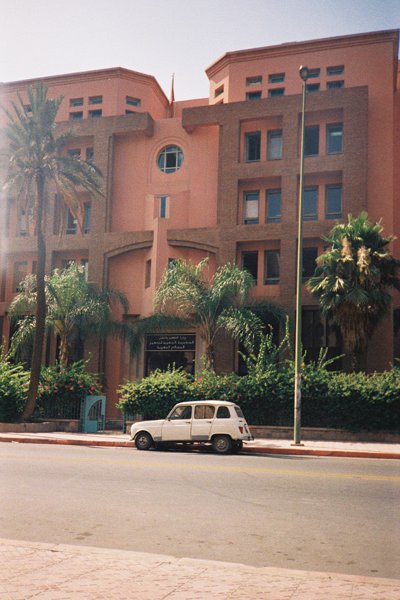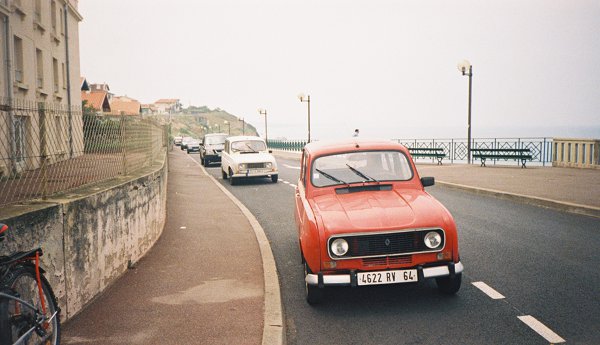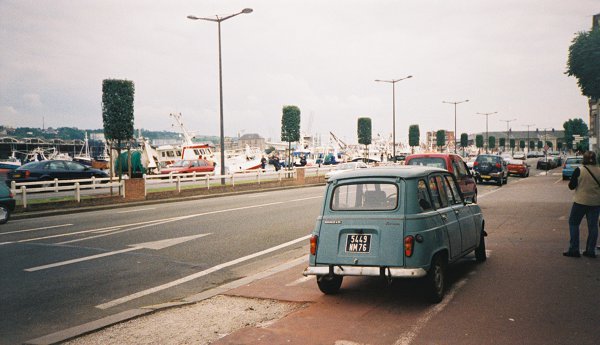
Renault 4 Rail Tales
page 3 of 3
by Peter Gumbrell, 6 December 2003
Lisbon - Marrakech - Hove
Having left Lisbon by way of a boat across the Tagus, I then hopped on a train to the Algarve. The landscape of low undulating hills began as the home to varied agriculture, but towards the south this gave way almost exclusively to endless rows of citrus groves. There were very few urban developments, just rustic villages and small farms that often had a trusty Renault 4 sitting in the yard. Several dusty villages and towns were dotted around Portugal, and despite the bruised body state of many of the cars (this partly due to the sometimes erratic driving behaviour and haphazard parking arrangements of locals), these Renault 4s were guaranteed to have decent undersides free from the level of rot common in wet countries such as Britain. It was becoming an increasingly likely prospect for British R4 seekers to salvage a model from a dry country like this. Although body panels could still be relatively easy to source, chassis repair or replacement would rarely be an option due to the enormous costs involved, and the low value of the car.
It had half been my intention when setting off on my travels to photograph as many Renault 4s around Europe as possible, and stick them up on the website, but from the moment I arrived on foreign shores in Dieppe I gave up on the idea. They were not apparent in plentiful numbers until I reached Spain and Portugal, but there were still enough dotted around France to put me off the idea of snapping each and every one, else my adventure would become a bore as I stuttered every half an hour to get my camera out. Most of the R4s were quite average, rarely in a well preserved state, and not of any specific interest for the site except for providing yet another R4 picture to accompany the many hundreds already displayed. And this was a noticeable problem. Most owners that I spotted were middle-aged or elderly persons who didn't seem to have much of a care for the cars. Rather, they regarded them as a cheap, practical runaround that could simply be ditched once expired. João and Fernando had told me how they regarded most owners in their country as fitting this category, and so they were battling against the tide in being young and so proud of the little cars. In Britain, myself and other R4 owners faced a similar situation of being unique and rather oddball for our preference of driving the car, except our individuality was more a result of there being so few left on the streets.
Would the R4 die out in Britain within the next decade, with just a few lone examples surviving in collectors' garages for occasional presentations? Or would the status of the car ever be elevated enough for greater appreciation, with attempts made at restoration and recovery to keep the Renault 4 running for generations to come, as was already the case with similar classics such as the Morris Minor, VW Beetle and Mini? Renault had phased out production of the car in the early 1990s for all sorts of complex reasons, much due to new laws regarding the safety features required in vehicles. There could be no doubt that large scale production of the R4 was finished, and that reproduction of its original form would be limited by these factors, confining such activity to small enthusiasts' workshops. The only long-term future of the car seemed to lie in some sort of redesign, which could spoil its character completely, as I believed strongly was the case with the 'New' Beetles and Minis. Personally, I would hate to see such treatment of the R4 in this way, with legions of artificially trendy people leaping on the bandwagon and buying up some inferior new retro version of the car. Some sort of middle way would need to be found, with fans the world over working together and improving only those aspects of the design essential for continued production, and leaving the rest of the car's image intact. I had been cultivating an idea for some time that I should launch a new section on the website devoted to such matters, and so at some later point it would become an aim to gather together as much ideas and information as possible in one place, related to the future of the R4. In the meantime, I had some travels to complete, and I was still heading south, yet to reach the halfway point of the voyage in Morocco. Two days after leaving Lisbon, I arrived in Seville in baking temperatures of more than forty degrees celsius.
On my way wandering from the centre of the city to the youth hostel, I passed a green R4 being used to advertise some sort of auto parts garage (below).
I left my card on the windscreen of a few Renault 4 models abroad, in the hope of startling some foreign owners into thinking my website was a far more organised operation than was the reality. Hopefully, people would think that I had an army of representatives travelling around the world leaving calling cards as international Renault 4-Play ambassadors, when in actual fact I was just some guy who wrote a load of twaddle from the PC in his bedroom, and who happened to be passing through. Two days later, I was in another scorching Spanish city, Córdoba, where I found a white model parked in one the city's main boulevards (below).
All the R4s on this page can also be found on the mystery cars page of the gallery, since I know not to whom any of them belong (see numbers MC69-73).
On the seventeenth day of my travels, I ventured onwards to Africa. The ferry from Algeciras to Tangiers dumped me in what was once a land of Renault 4s, or so I was led to believe. They had once been used as taxis in many Moroccan towns and cities, but had now been replaced by green Peugeots and other more luxurious models such as Mercs, many of which were waiting for me at the port. I journeyed south by train to Marrakech, and my one day spent in the city must have presented over a hundred Renault 4s around every street. Once again they were all white, and often in a somewhat decrepit state, although this could be said about most of the traffic in general, since the Moroccans' way of driving left a lot to be desired. Many of those I saw had probably been used as taxis, but amongst the private models, some would surely be bargains for comparitively rich Europeans to snap up in future years.
I took only one photograph in the city, and it featured an average white R4 parked in one of the large boulevards. There was nothing special about this model, but maybe somebody, somewhere would one day recognise it for missing one of its grey plastic side panels (below).
My visit to Morocco was brief. I took another sleeper train back to Tangiers after just fourteen hours spent in this sub-tropical central part of the country, and returned to Spain where I ventured on to Granada, an Andalucian city sited in the spectacular surroundings of the Sierra Nevada. My attempts to continue to eastern Spain and Barcelona were thwarted by the congested rail network, which had no services with spaces available for several days, so I was forced to return northwards via Madrid, and the same route through the Basque Country from which I came. It was tempting to stop again in San Sebastián and say another hello to Luis and Asier two weeks on, but I had only a week remaining to try and cover the remaining countries valid on my Interrail pass, namely Luxembourg, the Netherlands and Belgium.
I stopped for the weekend instead at Biarritz in the south-west of France, where I spotted another two Renault 4s parked up on the cliff above the town's southern beach (below). More were spotted around the town, including a couple parked down by the youth hostel. One of the guys who worked there eyed my R4 t-shirt and told me he was particularly keen on the cars. In France, the vehicles hadn't yet died out, at least not in the sunnier, southern parts of the country, but numbers were still decreasing too quickly for comfort. Again, they were too often regarded here as basic runaround cars with no value, that could be scrapped once something went wrong.
I managed to complete my circuit of the countries covered in my Interrail zones, passing through Lyon, Luxembourg City, Maastricht, the Belgian city of Tournai and another quick dip into Paris before my return to Britain. On the final day at Dieppe station, I stepped off the last train of my adventures, and on the way walking to the port I passed what was to be the last Renault 4 of the trip (below), a rather tatty turquoise Savane model with a cracked windscreen.
I had practically seen more Renault 4s during my travels than I had throughout my whole life, barring the two hundred or more found at the 40th anniversary event in Arnhem two years earlier. Although it was encouraging to see so many were still a part of daily life abroad, with over eight million of the vehicles produced it was also sad to see relatively few remaining, and these often in a poor state. I reflected on my trip, realising that something would have to be done soon to save these cars from further obscurity. Might the long and inimitable history of the R4 still have some twists in its tale?
Further reading on all my travels can be found at the site www.railtales.me.uk
<< previous article | next article >>
